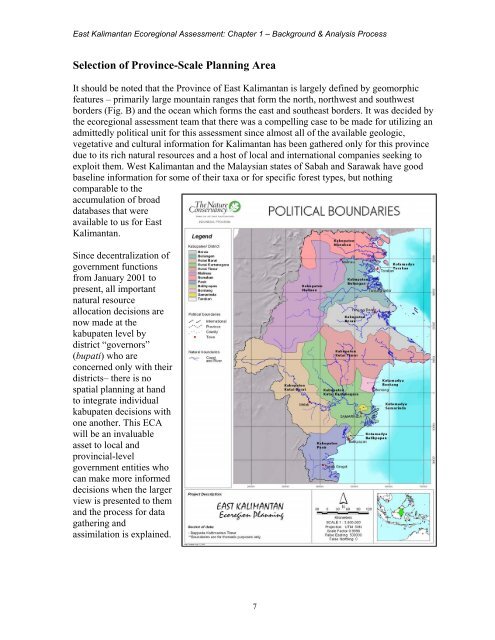Ecoregional Assessment of Biological Diversity in East Kalimantan
Ecoregional Assessment of Biological Diversity in East Kalimantan
Ecoregional Assessment of Biological Diversity in East Kalimantan
Create successful ePaper yourself
Turn your PDF publications into a flip-book with our unique Google optimized e-Paper software.
<strong>East</strong> <strong>Kalimantan</strong> <strong>Ecoregional</strong> <strong>Assessment</strong>: Chapter 1 – Background & Analysis Process<br />
Selection <strong>of</strong> Prov<strong>in</strong>ce-Scale Plann<strong>in</strong>g Area<br />
It should be noted that the Prov<strong>in</strong>ce <strong>of</strong> <strong>East</strong> <strong>Kalimantan</strong> is largely def<strong>in</strong>ed by geomorphic<br />
features – primarily large mounta<strong>in</strong> ranges that form the north, northwest and southwest<br />
borders (Fig. B) and the ocean which forms the east and southeast borders. It was decided by<br />
the ecoregional assessment team that there was a compell<strong>in</strong>g case to be made for utiliz<strong>in</strong>g an<br />
admittedly political unit for this assessment s<strong>in</strong>ce almost all <strong>of</strong> the available geologic,<br />
vegetative and cultural <strong>in</strong>formation for <strong>Kalimantan</strong> has been gathered only for this prov<strong>in</strong>ce<br />
due to its rich natural resources and a host <strong>of</strong> local and <strong>in</strong>ternational companies seek<strong>in</strong>g to<br />
exploit them. West <strong>Kalimantan</strong> and the Malaysian states <strong>of</strong> Sabah and Sarawak have good<br />
basel<strong>in</strong>e <strong>in</strong>formation for some <strong>of</strong> their taxa or for specific forest types, but noth<strong>in</strong>g<br />
comparable to the<br />
accumulation <strong>of</strong> broad<br />
databases that were<br />
available to us for <strong>East</strong><br />
<strong>Kalimantan</strong>.<br />
S<strong>in</strong>ce decentralization <strong>of</strong><br />
government functions<br />
from January 2001 to<br />
present, all important<br />
natural resource<br />
allocation decisions are<br />
now made at the<br />
kabupaten level by<br />
district “governors”<br />
(bupati) who are<br />
concerned only with their<br />
districts– there is no<br />
spatial plann<strong>in</strong>g at hand<br />
to <strong>in</strong>tegrate <strong>in</strong>dividual<br />
kabupaten decisions with<br />
one another. This ECA<br />
will be an <strong>in</strong>valuable<br />
asset to local and<br />
prov<strong>in</strong>cial-level<br />
government entities who<br />
can make more <strong>in</strong>formed<br />
decisions when the larger<br />
view is presented to them<br />
and the process for data<br />
gather<strong>in</strong>g and<br />
assimilation is expla<strong>in</strong>ed.<br />
7

















